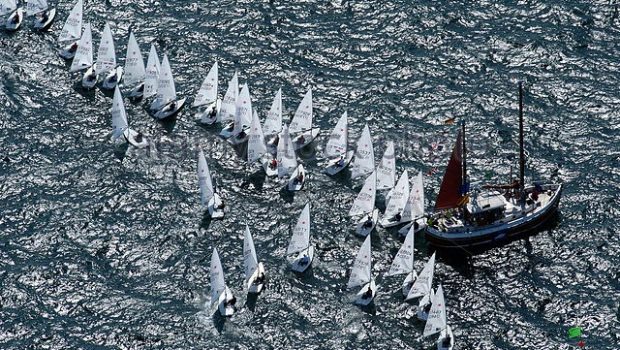Start Where Others Are Not
Published on August 23rd, 2017
Ken Legler, as a longtime coach at Tufts University and traveling Principal Race Officer, is an expert at watching how fleets of boats start. In Tips4Sailing, Ken shares advice on how to improve your odds at the beginning of a race.
Most racers are taught to start at the favorite end. The most common way of finding the favored end is by sailing to the line and pointing the bow into the wind. If the bow is angled closer to the committee boat end then that end is favored, and if the bow points more toward the pin then the pin end is favored. Got it. There’s just one problem. The favored end is the crowded end and the crowded end is where most of the bad starts happen.
Most of what you read from the experts about starting, including here, will tell you to start at the favored end. This is excellent advice for starting on long lines in open water in big fleets. But many of us race close to shore in short course racing such as high school, college, frostbiting or just beer can racing on summer Wednesday nights. The very best advice I can give you for short inshore racing is “Start where the others are not.”
Inshore races nearly always have oscillating winds shifting back and forth. If the starting line is set anywhere close to square to the mean wind direction then just about any point on the line can be a good place to start. You do not need to “win the start” in order to win the series. The goal of the start should be the ability to go straight after the start to use your full speed until you have the freedom to tack on the shifts.
Case in point:
The RC sets a decent line about square to the first mark which is approximately upwind relative to the mean wind direction. At three minutes before the start the wind shifts right 20 degrees. Half the boats take a wind shot to determine that the boat end is the upwind end and decide to start there. The right shift holds all the way to the start, even a half minute beyond.
One boat at the right end takes the start. Every other boat crowded in at the right end has less than the perfect start. Some start behind, some are forced over early, some are caught barging and circle out, some get back-winded and tack into the header, and worse some get fouled.
Meanwhile, it’s really easy to start down the line where the others are not. This might be good for the second or third best start in the fleet, until the wind oscillates back to the left. Bingo, first place; and if it doesn’t shift back, okay you are in third, a possible series winning average.
How to know where the others will not be:
Look at their wind shots to determine where you think they will start. Watch the traffic patterns during the sequence. There might be many boats on the left half of the line at two minutes but if they are all tacking to port and heading right, the left might soon be clear. If, on the other hand, you are on port at one minute and a large pack of boats are luffing on the lower third of the line, keep going on port until you get to the least dense area.
One of the reasons this works so well is that many skippers, particularly male skippers, have big egos. Those egos convince them they can “win the pin” or “win the boat.” But to win the series you should play the odds. Get a clean start, race after race after race, in order to use your speed and not your protest voice.









 We’ll keep your information safe.
We’ll keep your information safe.